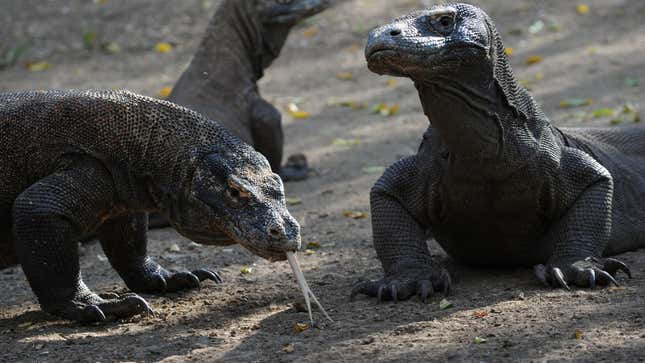
Who wants their next vacation to be on an island filled with large, carnivorous reptiles? Raise of hands? Anybody? Well, hand-raisers, whoever you are, have I got the opportunity for you.
The government of Indonesia recently announced plans to create new tourist hubs in Komodo National Park, the home of the majestic, foul-mouthed lizard that shares its name. Established in 1980 as a protected refuge for the scaly beasts, the park encompasses a constellation of three large Indonesian islands and 26 smaller ones, the likes of which are characterized by rugged, hilly terrain and a hot climate. In 1991, the park was declared a United Nations Educational, Scientific and Cultural Organization (UNESCO) World Heritage Site—which means that it enjoys a certain amount of U.N. legal protection due to its status as a site of outstanding “cultural and natural heritage.”
However, Indonesia’s plan to transform the islands into a “World-Class Ecotourism Destination” (as it has been put) has stirred up a little bit of controversy. Part of the problem is that it’s not totally clear what the government is actually planning. The islands already enjoy a certain amount of annual tourism, though the project’s backers hope to drive as many as 500,000 yearly visitors to the region (about twice the “pre-COVID-19 pandemic visitor numbers,” according to UNESCO numbers). Again, it’s not 100% clear how—though it is believed that new infrastructure projects are being developed. Due to all the mystery, last year people on social media started comparing the project to “Jurassic Park,” Reuters reports, in reference to another example of tourism based around giant lizards.
Most problematically, UNESCO has publicly complained that the project—whatever it is—may disturb the habitat of the dragons, as well as piss off the islands’ local community. At a World Heritage Committee conference meeting last month, UNESCO officials said that the project needed a new environmental impact assessment to determine whether it will disturb the islands’ inhabitants—man and reptile alike. UNESCO apparently communicated this to Indonesia, but never got a reply. A senior official with Indonesia’s environment ministry subsequently told Reuters that they’re working on an assessment and will have it ready by September.
While the country’s plans will certainly not lead to Spielbergian carnage, there is surely some question as to whether it’s a good idea to encourage large amounts of people to visit an island filled with meat-eating lizards.
Komodo attacks on humans are extremely rare but when they do happen, it’s truly nightmare-level shit. Dragons can run 12 miles per hour and have large, venom-laced chompers, which allow them to basically incapacitate you with a single bite (though they’re known to bite you a lot). If untreated, a significant percentage of people die within a couple hours of attack. The fact that they’re kind of cute doesn’t make up for the fact that they have been known to occasionally raid Indonesian villages—busting into random houses to munch on an arm or leg. In 2001, Sharon Stone’s then-husband tried to commune with one at a Los Angeles zoo and subsequently had part of his foot bitten off in front of a bunch of school children (not super important information but seemed worth sharing).
Anyway, I don’t mean to dragon-shame. Komodos are really cool and, historically, attacks are very rare—occurring if you’ve encroached on their territory, are being an idiot, or if their food supply has been overwhelmingly poached by hunters. And, in this case, UNESCO officials are clearly worried most about the well-being of the lizards, not the tourists. Officials have written that the new installations and tourist influxes could disturb the ecosystem that allows the some 3,000-ish Komodos to thrive on the islands.
Nonetheless, the Indonesian government seems to have made up its mind. It was reported in February that officials were rushing to complete construction on its project before next year’s G20 summit, which will be held in Indonesia. The summit was originally scheduled to take place in Labuan Bajo, a small fishing town with easy access to Komodo National Park, though it has since been changed to a venue in Bali.